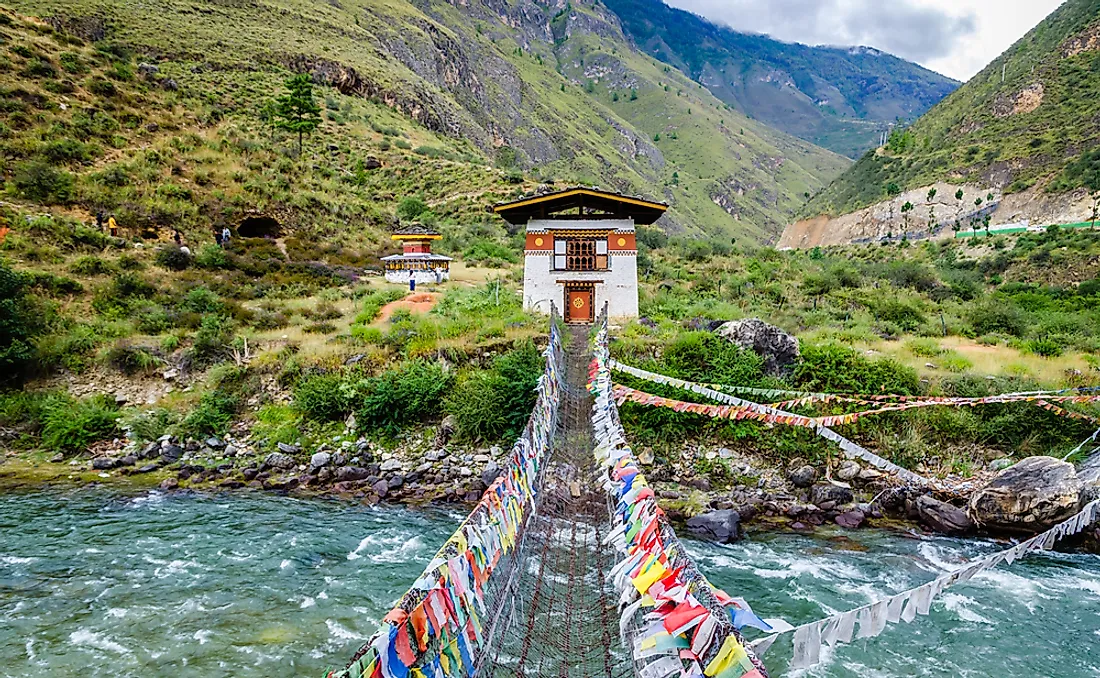Ecological Regions Of Bhutan

The Kingdom of Bhutan is a landlocked country in the South Asia. The country is separated from Nepal by the Indian State of Sikkim and from Bangladesh by the Indian State of Assam. Bhutan borders both China and India to the North and South respectively. The country lies between latitude 26oN and 29oN and longitude 88oE and 93oE. The climate of the country varies depending on the elevation with subtropical dominating the south and temperate in the highlands. Bhutan experiences five seasons including summer, winter, spring, monsoon, and autumn. The country is divided into different ecological regions which include,
Brahmaputra Valley Semi-Evergreen Forests
Brahmaputra Valley Semi-Evergreen Forests represent a patch of evergreen forest in the upper plains of Brahmaputra River. The ecoregion lies mainly in the Indian State of Assam and the southern lowland of Bhutan. The Brahmaputra River is a significant geographical barrier for most of the species within the ecological region in the country including golden langur and the hispid hare. The area receives an annual rainfall of between 1500 and 3000mm depending on the topography. The vegetation is influenced mainly by the rich alluvial deposits and the monsoon rains. This ecoregion is home to India’s largest elephants, one-horned rhinoceros, tigers, and white buffalos. There are also more than 370 species of birds and 122 species of mammals in this region. Almost 75% of Brahmaputra Valley Semi-Evergreen Forests has been cleared or degraded especially for grazing and human settlement.
Himalayan Subtropical Broadleaf Forests
Himalayan Subtropical Broadleaf Forests lies within the Himalayan Range and is a long narrow ecoregion which extends into the Bhutan. It represents series of ridges and valleys that rise above 5000m including some of the tallest mountain peaks in the world. Rainfall in this ecoregion varies from east to west with a maximum rainfall of 2000mm the forest is rich in biodiversity, and the forest type varies because of the subtropical forest, topography, and the rich alluvial soil. Many of the mammals in the ecosystem are threatened species including tigers, golden langur, Asian elephant, clouded leopard, gaur, and Irrawaddy squirrel. There are over 340 birds’ species including white-winged wood duck and hornbill species. More than 70% of the ecoregion has been cleared or degraded with cultivation and human settlement being a significant threat.
Terai-Duar Savanna and Grasslands
Terai-Duar Savanna and Grasslands covers the base of the Himalayas and runs from Nepal to part of Bhutan. The habitats for the ecoregion include savannah grassland, deciduous forest, and thorn forest. The climate ranges from hot and humid during summer with temperatures reaching a high of 40oC. The ecoregion is a home to a large number of tigers, rhinos, and ungulates. There are also five deer species supported by the grassland and floodplains. Many endangered mammals including Asiatic Wild Buffalo, hispid hare, and pygmy hog are also found in this ecoregion. Logging for industrial wood is a major threat on this ecoregion. The growing population has also led to the human settlement within the ecoregion.
The ecological regions in Bhutan are divided into six Biomes including Tropical and Subtropical Moist Broadleaf Forests, Tropical and Subtropical Grasslands, Savannas, and Shrublands, Tropical and Subtropical Coniferous Forests, Temperate Coniferous Forests, Temperate Broadleaf and Mixed Forests, and Montane Grasslands and Shrublands
Ecological Regions Of Bhutan
| Rank | Ecological Regions of Bhutan | Biome |
|---|---|---|
| 1 | Brahmaputra Valley Semi-Evergreen Forests | Tropical and Subtropical Moist Broadleaf Forests |
| 2 | Himalayan Subtropical Broadleaf Forests | Tropical and Subtropical Moist Broadleaf Forests |
| 3 | Terai-Duar Savanna and Grasslands | Tropical and Subtropical Grasslands, Savannas, and Shrublands |
| 4 | Himalayan Subtropical Pine Forests | Tropical and Subtropical Coniferous Forests |
| 5 | Eastern Himalayan Subalpine Conifer Forests | Temperate Coniferous Forests |
| 6 | Northeastern Himalayan Subalpine Conifer Forests | Temperate Coniferous Forests |
| 7 | Eastern Himalayan Broadleaf Forests | Temperate Broadleaf and Mixed Forests |
| 8 | Eastern Himalayan Alpine Shrub and Meadows | Montane Grasslands and Shrublands |











